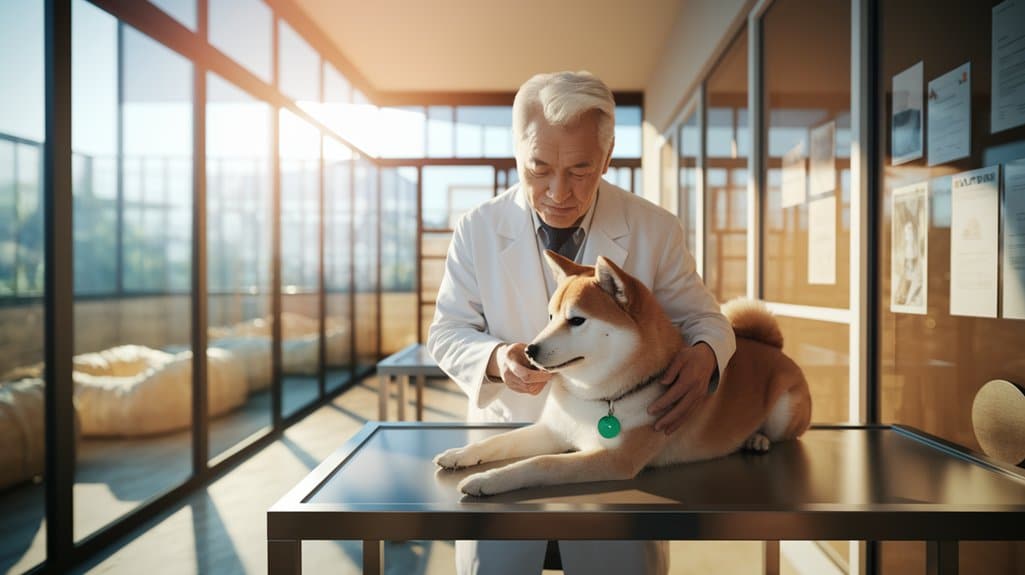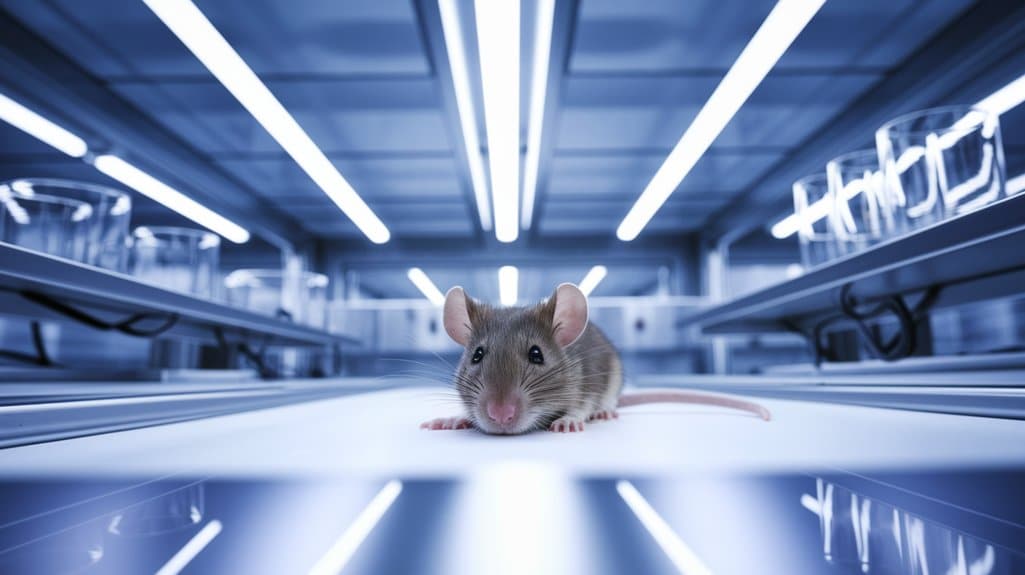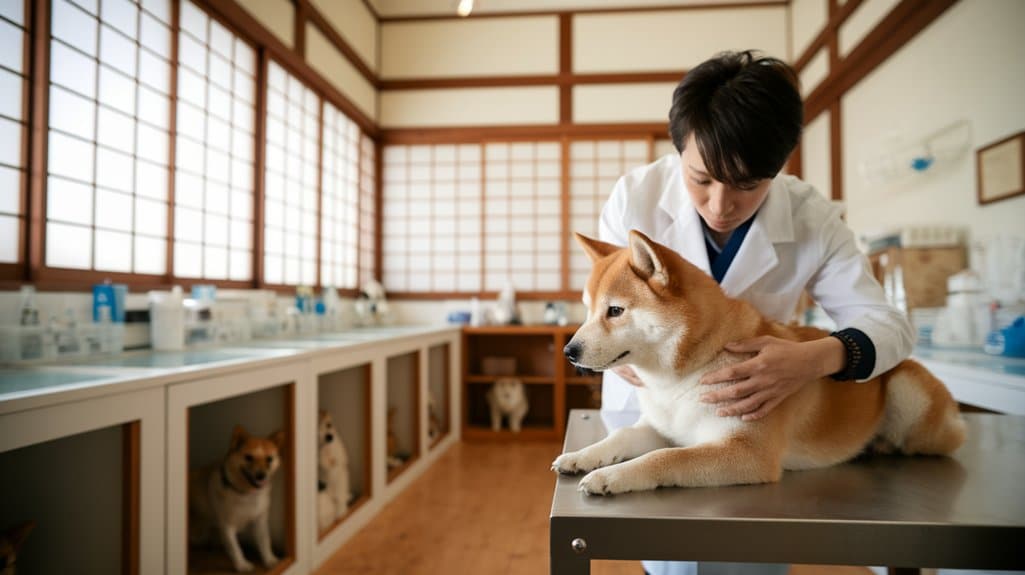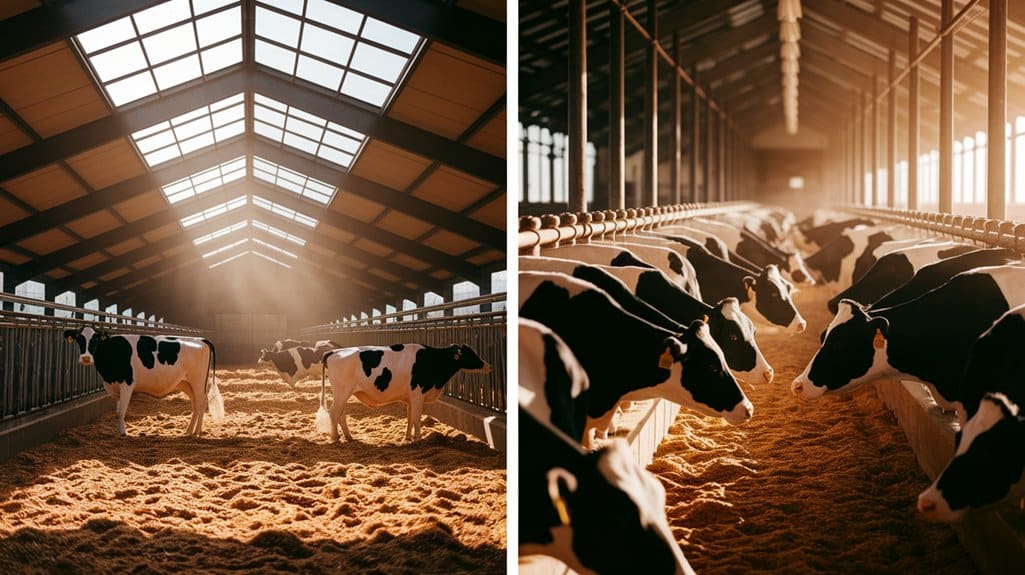
You’ll find Japan’s relationship with animal welfare fascinatingly intricate, shaped by Buddhist principles of compassion yet challenged by modern industrial demands. While the country’s 1973 Animal Protection Act marked a crucial shift toward legal safeguards, today’s practices often fall short of international standards. From the controversial dolphin hunts to cutting-edge lab testing guidelines, Japan’s evolving stance on animal rights reveals a nation grappling with tradition, innovation, and ethical responsibility.
Table of Contents
Toggle
Japan’s journey in animal protection laws has deep roots, intertwined with the country’s rich cultural history. It all began with a strong influence from Buddhism and the shifting perspectives on meat consumption. Take, for instance, Emperor Tenmu’s meat ban in 675. This edict reflected a pivotal moment where the values of compassion began to take precedence in society. As we move forward to Tokugawa Tsunayoshi’s 1687 reinstatement of these prohibitions, it’s clear that Buddhist principles continued to guide governance.
Transitioning into the modernization era, Emperor Meiji’s decisions from 1872 altered the landscape dramatically by lifting the ban on meat consumption. This change signified a major societal shift as Japan opened its doors to new ideas and international influences. The Act places significant emphasis on promoting animal welfare and respect among citizens.
Fast forward to 1973, when the Act on Welfare and Management of Animals made a significant impact by criminalizing cruelty and setting standards for animal care. This was more than just legislation; it was a reflection of Japan’s evolving social consciousness. As we examine the nuances within the law, we notice how each amendment closely aligns with society’s developing values. For example, the introduction of the Three Rs—Replacement, Reduction, and Refinement—in 2005 marked a progressive stance in ethical animal testing. Then came the 2012 regulations, which imposed stricter guidelines on pet sellers, aligning with a growing recognition of animals as companions deserving of care.
While enforcing these laws can be complex, each step forward underscores Japan’s ongoing effort to balance its cherished traditional values with the rising importance of contemporary animal welfare. In this delicate dance between history and progress, the story of Japan’s animal protection laws continues to unfold, reflecting a nation that cares deeply for all living creatures.
Japan’s Act on Welfare and Management of Animals, established in 1973, lays the groundwork for animal rights but illustrates a complex blend of advancements and ongoing challenges. The law rightly addresses unnecessary cruelty and mandates appropriate care for animals. Yet, there are notable gaps, particularly concerning the treatment of farm animals and those used in laboratory settings.
Enforcement of these laws resembles a well-meaning initiative that faces real-world hurdles. Prefectural officials hold the responsibility for ensuring adherence to the regulations, yet they often find their resources stretched thin. This situation leaves animal welfare advocates feeling concerned; despite the existence of penalties for instances of neglect and abuse, the effectiveness of law implementation varies significantly. The disparity between intent and action reveals a pressing need for improvement in how we uphold these vital protections for animals. To promote public understanding, the government has designated Be Kind to Animals Week from September 20-26, featuring educational events and community engagement activities.

The landscape of animal testing in Japan is a complex tapestry woven with both traditional values and modern ethical considerations. Here, voluntary guidelines often take center stage, and facilities strive to adhere to the established Three Rs principle: replacement, reduction, and refinement. It’s an approach that seeks to balance scientific advancement with compassion for our fellow creatures.
Examination of the current regulatory environment reveals some notable challenges. The IACUC designation remains only a recommendation rather than a mandate under Japanese law. Compliance with these guidelines is largely voluntary, which can lead to limited oversight. This self-governing system, while noble in intent, raises questions about accountability and the actual conditions faced by laboratory animals.
Transparency remains another area of concern. Many in the public are unaware of what goes on within the walls of testing facilities; limited disclosure leaves a gap in public consciousness. This lack of information can hinder meaningful dialogue and understanding of the welfare issues at hand.
Standards across different institutions can vary significantly, creating a patchwork of practices. This inconsistency not only complicates assessments of animal welfare but also affects the broader perception of Japan’s commitment to ethical treatment.
In terms of international comparison, Japan’s stance sets it apart from the stringent regulations seen in the European Union, especially regarding the prohibition of cosmetic testing on animals. It’s noteworthy that while the ethical oversight of such practices exists through institutional review committees, data on testing numbers and conditions remains scarce. This clouded picture keeps many stakeholders questioning the actual state of animal welfare in the nation.
As we navigate these complexities, the commitment to ethical practices, transparency, and improvement is essential. By fostering open dialogue and striving for higher standards, we can honor the delicate balance between science and compassion that is inherently part of our cultural heritage.
You’ll find Japan’s legal framework for farm animal welfare surprisingly sparse – the 1973 Act on Welfare and Management of Animals lacks specific regulations for livestock, leaving most practices to industry self-regulation. Today’s farming industry operates with remarkably high animal densities, where you might see egg-laying hens confined to spaces smaller than a sheet of paper, and broiler chickens packed at nearly double the global standard density. Where other nations enforce minimum space requirements, Japanese farms continue to operate without mandatory standards for livestock housing. While a growing movement of activists and concerned citizens pushes for stricter regulations and improved conditions, they face an uphill battle in a country where three-quarters of the population isn’t familiar with the concept of animal welfare.
Japan’s animal welfare legislation, crafted in 1973, is intriguing in its structure. It offers a broad protective framework for various species, including cattle and domestic ducks, yet it lacks specific regulations for farm animals. This presents a unique challenge in balancing the diverse needs of different animal groups.
The enforcement of this law relies significantly on self-regulation, which means local officials have limited oversight. While penalties such as imprisonment or fines exist for those found guilty of animal cruelty, the reality is that monitoring remains quite sparse. This situation allows for notable gaps within the legislative framework. Current practices permit painful physical alterations without anesthesia, including tail, beak, and fang removal. Consequently, Japan finds itself behind many global standards concerning animal welfare practices, particularly concerning livestock density and the methods of slaughter.
Despite these shortcomings, the cultural conversation around animal rights is beginning to evolve. There’s an increasing awareness among the public about the importance of enhancing legal protections and integrating more ethical considerations into animal care. Such momentum in reform initiatives may pave the way for a more robust framework that respects the rights of animals.
While global standards advocate for the “five freedoms” of animal welfare, the reality of modern farming in Japan presents a different narrative. Egg-laying hens often find themselves confined to spaces as small as 285 square centimeters, akin to attempting to live within a cramped closet. Such conditions lead to significant health risks; for instance, the risk of trampling during inspections is prevalent, and diseases can spread swiftly in these overcrowded environments.
It’s understandable that consumers face a dilemma. Many are aware of the welfare issues yet hesitate to invest in higher-priced, humanely raised products. This reflects a tension between ethical considerations and economic realities, where the desire for compassionate choices may clash with financial constraints. A delicate balance exists, as understanding and awareness develop in this complex landscape of agriculture. Surveys indicate that only 25% of consumers have knowledge about animal welfare practices and standards.
In the world of animal welfare, the movement for farm animals in Japan often resembles a struggle between the small and the mighty. Organizations like ARCJ and VegeProject Japan champion the cause, working tirelessly amidst a landscape filled with cultural and regulatory challenges. Their dedication is commendable, though the path forward is steep and winding.
You may observe passionate individuals standing up against fur farms or engaging city dwellers with vegan campaigns. Yet, the plight of farm animals hasn’t truly resonated with the masses in the same way as pet welfare has. The existing 1973 Act on Welfare and Management of Animals leaves significant gaps, particularly when it comes to the protection afforded to farm animals. Defamation laws severely limit activists’ ability to campaign against specific companies. Activists often navigate the complexities of limited resources and a public still awakening to these issues.
Despite these obstacles, there is a glimmer of hope. Collaborations on an international scale and evolving educational efforts are gradually influencing public sentiment. These initiatives are essential in fostering a broader understanding of farm animal rights, encouraging a shift in consciousness that could lead to real change over time.
If you’re wondering about pet protections in Japan, you’ll find that the 1973 Act on Welfare and Management of Animals sets clear expectations for companion animal care, with penalties up to 1 million yen for abuse or neglect. While Japan’s push toward mandatory microchipping shows growing commitment to pet accountability, the country still grapples with high euthanasia rates in public shelters—though these numbers have improved since stricter adoption protocols were implemented. You might be surprised to learn that enforcement largely relies on citizen reporting, creating a community-based approach to animal welfare that’s uniquely Japanese in its blend of legal framework and social responsibility. The 2012 amendments to animal welfare laws established stricter regulations for dog and cat sellers to better protect companion animals.
Japan’s journey toward enhancing the welfare of pets has roots stretching back to 1973, with the Act on Welfare and Management of Animals standing as the essential regulation for companion animals. For anyone thinking of welcoming a pet into their life here, it’s important to be aware of the legal responsibilities that accompany pet ownership.
Firstly, providing proper care is not just a matter of compassion but a legal obligation. Neglecting a pet’s health and safety could lead to fines or even a prison sentence of up to one year. This underlines the gravity of ensuring that pets are treated with the utmost care.
When traveling internationally, pets must have ISO-compliant microchips. This is crucial to keep track of their identity and ensure their safety. To cross borders with your furry companion, complete health certificates are also a necessity. These documents act as proof of your pet’s well-being and protect both you and your pet during your travels.
If you find yourself in the pet retail business, be aware that there has been a tightening of regulations aimed at enhancing the welfare of animals in shops. Recent changes have established limits on pets per employee in retail establishments. These measures reflect a growing commitment to protecting our beloved companions.
Understanding these laws helps create a harmonious relationship between pets and their owners. Adhering to them not only promotes welfare but also contributes to a more compassionate society.
Japan’s approach to pet adoption has seen significant shifts over the past twenty years, reflecting broader societal changes. The decline in euthanasia, from an overwhelming 400,000 animals in 2004 to approximately 43,000 by 2017, illustrates the positive impact of enhanced animal sheltering practices. This encouraging trend, however, is met with a sobering statistic: only about 45,000 animals find their forever homes each year. The Japanese Ministry of the Environment provides comprehensive data tracking these adoption trends.
Adoption initiatives have begun targeting seniors, aiming to address the twin issues of animal homelessness and the isolation often felt by the elderly. Yet, persisting cultural preferences present a hurdle. A large portion of the Japanese population continues to favor purchasing pets from stores, with over 80% of dogs acquired through these retail avenues. It’s a subtle reminder that changing societal perspectives takes patience and dedication.
Striving for a balance between adoption and retail, the path toward more homes for these loving animals remains a work in progress. Each small shift contributes to a larger change, and the importance of education in this realm cannot be overstated. With continued efforts, the hope is that more hearts will open to the joys of adopting a pet in need.
Japan’s pet microchipping requirements reflect a deep commitment to animal welfare, focusing on identification, traceability, and responsible ownership. If you’re considering bringing your beloved companion to Japan or acquiring a pet locally, it’s essential to familiarize yourself with the benefits of microchipping and the necessary registration procedures to ensure their safety and well-being.
First, an ISO-compliant microchip must be implanted before your pet receives their initial rabies vaccination. The microchip must have a 15-digit numeric code that meets ISO standards. This crucial timing is non-negotiable and forms the basis for future identification.
Next, registration is vital. Within 30 days, you must register your pet in the Japan Veterinary Medical Association’s database, as well as with your local municipality. This action not only safeguards your pet but also facilitates a seamless way to reunite with them if they become lost.
If you are importing a pet, alerting the Animal Quarantine Service ahead of time is wise. This step prevents any potential for extended quarantine, allowing you to avoid unnecessary stress for both you and your furry friend.
Each microchip acts as a lifetime digital passport for your pet. It ensures they can be reliably identified should they ever stray from home. Understanding these essentials not only helps in protecting your cherished companion but also supports Japan’s commitment to responsible pet ownership.
In recent years, political advocacy for animal protection has gained significant traction within Japan’s legislative landscape. It’s interesting to observe how various political parties have woven animal welfare into their campaign platforms and policy proposals. For instance, the Liberal Democratic Party has taken steps to implement stricter regulations on animal dealers, while the Constitutional Democratic Party has focused on elevating the importance of animal rights. The government has been particularly responsive to initiatives aimed at cage-free conditions ahead of major events.
Collaboration among different parties is becoming more evident. For example, the Komeito party actively works to prevent animal hoarding, showcasing their commitment to ensuring the well-being of animals. Meanwhile, the Japan Innovation Party emphasizes the need to reduce stress among farm animals. This cross-party approach signals a shift in how animal welfare is perceived, moving it from a niche concern to a key topic in contemporary Japanese political conversations.
This transformation reflects an evolving understanding of the responsibilities we hold toward our animal companions, indicating a more unified approach to advocating for their protection in the political sphere. As discussions continue, the integration of these values into political discourse may well shape future policies for the better.

When you look at Japan’s animal welfare environment, you’ll find organizations like JAWS and ARCJ at the forefront of public education, running workshops and seminars that reshape how individuals think about animal protection. Led by Her Royal Highness Princess Hitachi, JAWS has established itself as a leading force in animal welfare for over six decades. These organizations don’t work in isolation – they’ve built impressive networks of collaboration, partnering with international groups like Wild Welfare and UK-based Animal Welfare Japan to enhance their impact. Through their combined efforts in advocacy and education, they’re turning animal welfare from a fringe concern into a mainstream conversation in Japanese society, even if they’re doing it on a shoestring budget that would make a zen monk look extravagant.
In Japan, organizations committed to animal welfare have established thoughtful public education strategies, which are essential for their advocacy efforts. By engaging in humane education and raising awareness about animal rights, these programs create a network that cultivates compassion and understanding toward our fellow beings.
Take, for instance, the AWJ’s annual school competitions. These events encourage young minds to explore animal welfare concepts through creative projects, allowing students to express their thoughts and learn actively. Community workshops and seminars play a crucial role as well, equipping participants with practical insights into responsible pet ownership.
In schools, innovative animal-rearing programs introduce children to empathy in a hands-on manner, as they learn to care for classroom pets. These experiences foster a connection to animals that transcends mere interaction. Moreover, public consciousness campaigns work diligently to emphasize the significance of preventing animal cruelty, reminding society of its moral responsibilities. Wild Welfare’s workshops have been instrumental in training zoo staff and veterinary students on proper captive animal care practices.
Such educational initiatives extend beyond simple teaching; they seek to transform the relationship between humans and animals. By imparting knowledge and cultivating empathy, society gradually nurtures a deeper respect for all living beings—one lesson at a time.
In Japan, animal welfare organizations have forged a remarkable network through collaboration and strategic partnerships. Leading groups such as the Animal Rights Center Japan (ARCJ) and the Japan Cat Network (JCN) exemplify this unified effort, operating at both local and international levels.
The impact of these partnerships is visible. For instance, ARCJ’s engagement in UN discussions allows them to influence global animal welfare policies. Meanwhile, JCN’s community-driven initiatives effectively foster positive attitudes towards animal care among local residents. These organizations are working together, pooling resources and sharing expertise, which leads to innovative and sustainable solutions in animal protection. Their high volunteer engagement has been crucial to implementing successful programs across the country.
One notable example of their collaborative efforts is the implementation of TNR (trap-neuter-return) programs, which help manage feral cat populations humanely. Additionally, their advocacy for cage-free farming reflects a broader commitment to improving conditions for animals. The collective strength of these organizations is making a noticeable difference in how animal welfare is approached in Japan, demonstrating the power of unity in effecting change.
The relationship between Japan and the concept of animal rights is quite intricate, shaped by deep-rooted cultural influences and public sentiment. Many Western countries embrace animal rights as a standard movement, but in Japan, the discussion often arises from emotions rather than clear ethical guidelines.
You might find it intriguing that in Japan, the notion of animal rights can be perceived as somewhat radical. Activists advocating for these rights are frequently labeled as extreme. This perspective creates a barrier to broader acceptance of animal welfare initiatives. Recent surveys show that exotic pet ownership has risen significantly, particularly among younger demographics.
When discussing animal welfare, decisions often stem from personal feelings rather than established protocols. This subjectivity plays a significant role in shaping how individuals interpret the treatment and rights of animals.
Cultural norms greatly influence perceptions of animal welfare in Japan. The approach here differs from Western viewpoints, resulting in a unique understanding of the relationship between humans and animals.
Despite a strong affection for companion animals—66% of adults express fondness for them—support for expansive animal rights movements remains limited. This reflects a complex balance between emotional attachment and the broader implications of animal rights within society.

Japan’s commitment to animal protection has evolved impressively over the years, especially with the establishment of the 1973 Act on Welfare and Management of Animals. This pivotal law marked the beginning of a comprehensive legal framework dedicated to the care and protection of animals in the country.
One noteworthy advancement came in 2013 when Shiseido made a groundbreaking decision to discontinue animal testing for its products. This move not only reflects the growing dedication to ethical practices but also sets a precedent for the beauty industry within Japan. Since 1987, the Animal Rights Center Japan has been at the forefront of advocating for corporate reform and promoting ethical living. Their persistent efforts have helped raise awareness and catalyze change across various sectors.
Local governments are stepping up as well, creating innovative animal care centers that address the needs of abandoned pets. These centers ensure that animals receive the necessary care and attention, reflecting a shift toward more compassionate community practices. The facilities now feature indoor and outdoor spaces for animals to exercise and maintain their well-being.
As we look back at Japan’s journey, it’s important to recognize the significant milestones achieved in animal welfare. From Emperor Tenmu’s meat ban in 675 to the current collaboration between NGOs and private enterprises, there’s a palpable progress toward a more compassionate society. Each step forward highlights the dedication to creating a better environment for all living beings.
In our journey towards enhancing animal welfare, it’s essential to acknowledge the complexities we face in implementing and enforcing protective measures across the country. Despite the progress made in legislation, the gap between these laws and their practical application remains a significant challenge. Cultural perceptions can often contrast sharply with contemporary animal rights standards, creating a mosaic of beliefs that complicates the pursuit of effective enforcement.
The existing legal framework tends to lean on self-regulation, which can lead to inconsistencies in how various industries adhere to animal welfare standards. This reliance makes it difficult to establish uniformity in enforcement. A further complicating factor is the limited public awareness concerning wildlife conservation. The rise of kawaii culture has led to treating pets as fashionable accessories rather than living beings requiring responsible care. This lack of understanding impedes efforts to address the exotic pet trade and enhance rescue operations, making it crucial to foster a deeper social consciousness.
Education plays a vital role in shifting the traditional view of animals merely as commodities. Engaging the public through accessible educational initiatives is key to facilitating this change, yet these programs often encounter obstacles. Additionally, those entrusted with monitoring animal welfare may face practical hurdles, including insufficient resources and lack of training, which can hinder effective enforcement.
For those devoted to animal rights, recognizing these gaps in implementation is crucial. By understanding the barriers, we can better strategize toward creating a world where animal welfare is truly prioritized and improved. Each step taken in awareness and advocacy leads us closer to effective protection for our fellow beings.

When observing the state of animal welfare in Japan through the lens of global standards, one encounters a situation that deserves careful consideration. The influence of Japanese culture brings about distinct perspectives on how we treat animals. Yet, when compared to leading nations, significant gaps in protective laws and practices come to light.
Take a look at the legal framework in Japan. Since 1973, there has been basic protection for animals. In contrast, other countries have established comprehensive laws that ensure better welfare for animals. Moving to farm conditions, Japan has limited regulations in place, while many nations enforce strict welfare standards that create more humane environments for livestock. Japanese visitors to zoos tend to focus on basic welfare factors rather than enrichment activities.
Animal testing presents another area of concern. Japan ranks second highest in the world for such practices, unlike other nations, where there is a noticeable decline in the use of animals for testing purposes. It’s also important to consider livestock density; Japanese farms often maintain high stocking rates, whereas countries with strong animal welfare policies regulate spacing to ensure the well-being of the animals.
Progress toward cage-free environments has been minimal in Japan. In contrast, numerous leading nations have embraced a widespread transition towards such practices, reflecting a deeper commitment to animal welfare.
While Japan may have fewer farmed animals per capita than many other places, the approach to animal welfare seems to lag behind international expectations. This is particularly evident in farming practices, where other developed countries have welcomed stricter regulations leading to more humane conditions for livestock.
As we look to the future of animal welfare in Japan, there are exciting developments on the horizon, coupled with some challenges that need to be addressed. The landscape of animal welfare legislation is transforming, driven by collaborative efforts among various stakeholders. Modernizing practices within research, agriculture, and animal care is a common goal.
The revised Animal Welfare Act has sparked ongoing dialogues regarding the welfare of laboratory animals. The launch of HSI and JCAW’s report marks a significant milestone in addressing animal experimentation concerns. This initiative is crucial, as it aligns Japan’s standards with those observed globally. The emphasis on the 3Rs principle—refine, reduce, replace—in scientific research reflects a significant shift toward more humane methodologies.
In the realm of livestock, a movement towards welfare-centric systems is gaining momentum. Adopting these practices requires careful consideration of economic factors as well, ensuring that the needs of animals and the realities of farming coexist harmoniously.
Japan’s future in animal welfare is set to change as it aligns with WOAH guidelines. Strengthening partnerships through trade agreements, such as the EU-Japan EPA, will further enhance welfare standards and practices. Each step forward presents an opportunity for a more compassionate approach to the care of animals, and it’s worth paying attention to these evolving standards as they take shape.

Japan’s animal welfare movement has its roots in modest pet protection groups. Like the delicate strokes of a brush on silk, this journey toward broader social change is intricate and not without challenges. Cultural nuances often create a landscape where grassroots mobilization meets resistance, shaped by a long-standing tradition that values harmony and societal stability, as well as legal frameworks that may deter confrontational activism.
Take organizations like the Animal Rights Center Japan and Animal Liberator, for example. They are recalibrating their strategies, choosing to engage with corporations and align their efforts with cultural values instead of relying solely on direct confrontation. This mindful approach reveals that progress often lies in illustrating how animal welfare policies can benefit society as a whole and in navigating Japan’s unique corporate decision-making environment. With only 3.5% cage-free hens in the country, these organizations face significant work ahead.
While the financial backing of such movements remains modest and the profession of activism is still finding its footing, signs of optimism are emerging. Partnerships between grassroots organizations and governmental initiatives are blossoming, especially with MAFF’s new guidelines and public forums. Through these collaborative efforts, there is potential for a more harmonious coexistence between traditional practices and modern welfare concerns. A journey worth pursuing, much like the art of creating beautiful skin, takes patience and care.